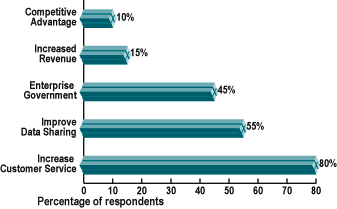ACROSS THE DIGITAL NATION

Electronic government initiatives are sweeping the nation, rapidly moving from the drawing board to implementation. In many respects, the focus of new online activity is centered on creating self-service applications to enable customers to complete entire transactions online.
Electronic government initiatives are sweeping the nation, rapidly moving from the drawing board to implementation. In many respects, the focus of new online activity is centered on creating self-service applications to enable customers to complete entire transactions online. Leading-edge public-sector agencies have developed a variety of solutions, from broad areas such as Internet tax filing and online motor vehicle transactions, to niche specialties such as e-permitting for hunting and fishing and e-licensing for marriage certificates. Although many of these initiatives focus on the government-to-citizen space, there is significant opportunity within the government-to-business sector. Already, there has been a lot of development in the e-procurement space. Other key G2B applications include business filings under the Universal Commercial Code, professional and business licensing and tax filing and reporting. In contrast to the G2C space, businesses have better technology infrastructure, higher demand for online services and a willingness to pay to interact electronically with government agencies.As these initiatives gain momentum and focus, many state and local governments are trying to understand what all this online activity should lead to. Government activity on the Web typically moves through four phases: presence, interaction, transaction and transformation. Over the next five years, government organizations will enter the transformation phase, probably the most complex and resource-intensive part of e-government development.The transformation phase focuses on revamping the organization of government service delivery to best reflect requirements of the customer groups. Some key technologies that will be used in this phase include customer relationship management (CRM), mobile devices and wireless access. In many respects, however, business and process consulting will be even more valuable as agencies develop new methods of working with one another and delivering services to their customers.A survey of state and local government agencies revealed public-sector organizations believe the transformation phase must reorient government services away from internal processes (stovepiped agencies and programs) and focus externally on customer requirements. That is, government agencies must ask themselves: What is my customer trying to do?Approximately 80 percent of the respondents indicated the net effect of e-government applications is to increase customer service. This will require CRM tools to understand customer requirements, document usage patterns and push valued information back to the customer. Using CRM solutions will force government organizations to focus on new ways of providing their services.The respondents also indicated the transformation must include changing core internal processes. Fifty-five percent called for improved data sharing across agencies, and 45 percent wanted greater focus on enterprise government, horizontal solutions that cut across agency lines. Not surprisingly, only 15 percent of respondents indicated the transformation should focus on increased revenue for government, and only 10 percent believed this phase should focus on competitive advantage.In many respects, the movement toward enterprise government may be the most complex aspect of the transformation phase. Enterprise government seeks to tear down the walls among agencies and create business processes around specific customer requirements. For example, the traditional way of starting a new business in a jurisdiction may require interaction with seven to 10 different agencies to obtain the necessary information: tax identification number, business license, professional license, health inspection, etc.In the transformation phase, government agencies will create customer-centric solutions that enable the business owner to go to one place to obtain all the necessary information. These new horizontal services will cut across government agencies to provide specified services to key customer groups. California just launched an online initiative called the E-Business Center to provide this level of service to the business community. Vendors targeting the e-government marketplace must strike a delicate balance between concentrating on current opportunities and preparing users for the next wave of development. Clearly, the focus on self-service solutions will continue to be a major part of e-government development over the next three years. However, to prepare for the next phase of transformation, vendors must also articulate a larger e-government vision for public-sector organizations and work toward that goal. Although there are steps taken toward the transformation phase, this will undoubtedly be the longest aspect of e-government development. Government organizations must be ready to undergo some growing pains and allocate significant resources and funding to truly transform government service delivery. There also needs to be some executive leadership within the jurisdiction to advance transformation initiatives, galvanize a diverse set of stakeholders and raise public awareness of government in action.


Rishi Sood is a principal analyst with Gartner Dataquest in Mountain View, Calif. His e-mail address is rishi.sood@gartner.com.

Rishi Sood

Rishi Sood is a principal analyst with Gartner Dataquest in Mountain View, Calif. His e-mail address is rishi.sood@gartner.com.

